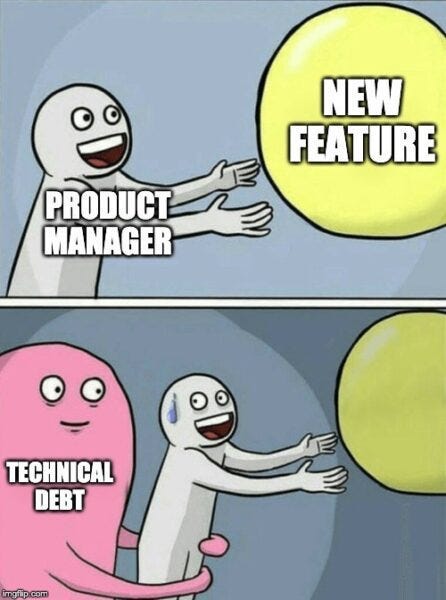Managing Technical Debt
Technical debt can be a silent productivity killer, and as Product Managers, we’re responsible for understanding its impact.
We can’t spend all our time addressing technical debt, but we must allocate enough space for it. While there’s no perfect formula, recognizing its importance and taking action can transform how we build products and improve our relationship with engineering teams. Technical debt can affect engineers’ productivity and work quality. By addressing it, we show our understanding and build stronger partnerships.
Image source: https://chrisfenning.com/the-seven-best-technical-debt-memes-to-make-you-laugh/
1. Set a Plan for Technical Debt ⏳
One key step is ensuring there’s a time buffer in our planning to address technical debt. This gives engineers time to tackle it. As product managers, we must understand its impact on customers, the product, developer productivity, security, compliance, and performance. Knowing the current situation and long-term implications is vital.
2. Assess the Broader Impact 🔍
Technical debt doesn’t just impact developers — it can affect customers, security, compliance, and performance. Understanding the direct and indirect effects ensures you’re prioritizing debt that has the most significant impact.
3. Collaborate with Engineers 🤝
Engineers are your partners in tackling technical debt. Involve them in discussions about prioritizing debt. They understand the trade-offs and can help guide decisions that align with your goals.
4. Be Transparent and Document Debt 📁
When building an MVP, we often create technical debt by taking shortcuts to deliver value faster. It’s normal, but we must be aware of the technical debt we’re creating and have a plan to address it in future iterations. This helps engineers understand that while we’re taking on technical debt, we’re also committed to addressing it. It’s a decision made together, not something that happens without awareness.
Technical debt is part of any product’s journey, but managing it proactively shows you’re committed to quality. How do you handle technical debt? Let’s share best practices!
Medium: //khrystynasosiak.medium.com/
WebPage: Learn product with Khrystyna
linkedin: Khrystyna Sosiak
More articles:
Context in Product Management: https://khrystynasosiak.substack.com/p/context-is-everything-in-product
Crucial Role of Focus: https://khrystynasosiak.substack.com/p/the-crucial-role-of-focus-for-product
See you next time,
Khrystyna Sosiak





This is what I personally like, high-level, to advocate when it comes to tech debt:
1. Have solid principles in place that prevent unnecessarily adding to it;
2. Should you have to take a shortcut -- clean it up the next opportunity you have (here's where reserving some capacity / space for that will pay off in the long run);
3. Use tech debt as gap filling of priorities for when that's reasonable (e.g., you are yet gathering more feedback to validate your latest launch, maybe that's an opportunity to let engineering tackle some tech debt they think should be dealt with now)